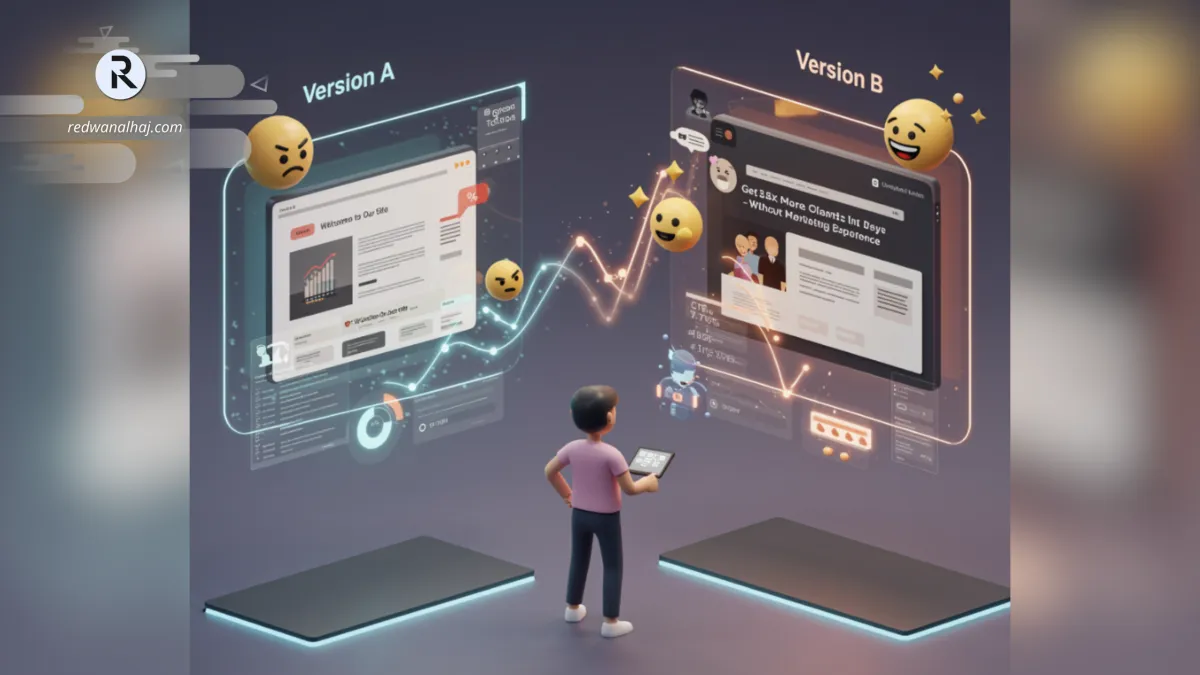
User Intent Secret | How to Write an Attention-Grabbing Title?
Table of contents
🧠 Visitors Don’t Leave Randomly: Analyzing User Intent Behind Clicks and Exits
Why Do Visitors Leave Quickly?
What Do Users Look for at First Glance?
The Headline: Your First Line of Defense
Common Mistakes in Writing Headlines
💡 Characteristics of a Strong Headline That Drives Clicks
Integrating Headlines with Surrounding Elements
Hero Subtitle: The Supporting Line
🔗 Connecting with Call-to-Action (CTA) Buttons
Importance of Connecting the Headline with the CTA:
🧱 How to Build an Effective Headline System for Your Entire Website (Smart SEO Approach)
1. Every Page = Clear Headline + Clear Result
2. Using Headlines to Target Different Intents
3. SEO and the Purpose of the Headline
👨🔬 Actionable Steps: Write Your Perfect Headline
🧠 Visitors Don’t Leave Randomly: Analyzing User Intent Behind Clicks and Exits
Introduction
Imagine a new visitor landing on your website. They have a problem and are looking for a quick solution. Their eyes scan the screen within the first 5 seconds. Yes, 5 seconds are enough for them to decide whether to stay or leave.

At this critical moment, the only thing they judge is the first impression. Research shows that the Bounce Rate (the percentage of people who leave quickly) can exceed 80% on websites that fail to grab attention immediately.
Often, the first element that shapes this impression is the headline. If it’s boring, generic, or doesn’t answer the question “What’s in it for me?”, you’ve lost the visitor before even saying hello.
People don’t have time to read and figure things out. They want to know at first glance if your website solves their problem. Understanding this behavior allows you to design a user experience that makes visitors feel they’ve come to the right place from the very first second.

Why Do Visitors Leave Quickly?
First Impressions Matter
The headline is the first thing visitors notice. If it’s generic or unclear, they’ll leave. Studies show that 80% of visitors bounce if they don’t find immediate value. You have just 5 seconds to grab their attention.

What Do Users Look for at First Glance?
When a visitor opens your website, they’re not asking, “What do you offer?” Instead, they’re asking, “What’s in it for me?”
Your headline, design, and even word choice must scream: “Here’s the result you’re looking for, and it’s right here!”
If they’re looking for a way to increase their sales, they need to see that result in front of them—not a description of your company.
If they want to learn a skill quickly, you need to speak their language and tell them it’s easy, suitable for them, and achievable in a short time.
The language must be simple, directly address them, and connect their current problem with the solution you offer. When you speak their language and address their concern, you win their first interaction—which is the first step toward conversion.

The Headline: Your First Line of Defense
Common Mistakes in Writing Headlines
Many websites lose conversion opportunities within the first 3 seconds—not because the service is weak, but because the headline is weak.
One of the biggest mistakes is using generic phrases that say nothing to the visitor, such as:
“We provide smart solutions for your business.”
“Professional service by all standards.”
These phrases could mean anything—or nothing at all.
Another mistake is focusing on “We” instead of “You”. When a visitor reads: “We help businesses grow,” they’ll ask: “What does that have to do with me?”
Meanwhile, an effective headline speaks directly to them:
“Double your profits from your first website visit—without writing a single line of code.”
The headline must be clear, direct, and address one person with a problem—and you’re the solution.

💡 Characteristics of a Strong Headline That Drives Clicks
Answers “What’s in it for me?”
The moment a visitor reads the headline, they should feel there’s something valuable for them.Clarifies the Benefit and Result
People love to know the tangible outcome. The headline should make it clear that they’ll achieve a satisfying result quickly or easily.
Example: “Double your sales from your website—no experience needed.”Includes a Hook or Curiosity Element
Use words that grab attention and spark curiosity, such as: “How,” “Without effort,” “Secrets,” or “Better than competitors.”Reflects the Visitor’s Problem and Offers a Clear Solution
Example: “Is your website failing to reach clients? Learn how to attract visitors in just 5 steps.”


Integrating Headlines with Surrounding Elements
Hero Subtitle: The Supporting Line
The Hero Subtitle follows the main headline and complements it perfectly. While the headline grabs attention and makes clear promises, the subtitle reinforces these promises and clarifies the benefit further.
Example:
Headline: “Launch Your First Profitable Digital Product in 5 Steps.”
Subtitle: “No experience, no complex tools, no wasted time.”
In this example, the headline sparks curiosity and encourages discovery, while the subtitle completes the picture and removes any concerns about challenges or difficulties.

🔗 Connecting with Call-to-Action (CTA) Buttons
It’s essential to strategically integrate the headline with Call-to-Action (CTA) buttons. If the headline sparks curiosity and promises a clear result, the next button should directly guide the visitor toward achieving that result.
Examples of effective CTAs:
“Start Now”
“Download the Free Plan”
“See Examples”
Importance of Connecting the Headline with the CTA:
Enhancing Clarity: The button should complement the promises made in the headline.
Direct Guidance: Each CTA button should guide the visitor one step closer to achieving the desired benefit.
Increasing Motivation: A strong CTA creates a sense of urgency and encourages immediate action.

🧱 How to Build an Effective Headline System for Your Entire Website (Smart SEO Approach)
To build an effective headline system for your website, you need an integrated strategy that aligns with SEO and meets the visitor’s intent.
1. Every Page = Clear Headline + Clear Result
Each page on your website should align with a specific goal. Whether the page aims to convert visitors into customers, educate them, or help them make a purchase decision, the headline must be direct and clarify the benefit the visitor will receive.
2. Using Headlines to Target Different Intents
Homepage: The intent here is conversion. The headline should motivate the visitor to take the first step, such as “Start Now” or “Discover How We Can Help You.”
Service Pages: The primary goal of these pages is to convince the visitor to try the services. The headline should reflect the direct benefit the visitor will receive, such as “We Help You Design a Website That Attracts Clients Effortlessly.”
Educational Pages or Articles: The goal is to educate the visitor and build trust. Headlines here should be educational and clear, such as “Everything You Need to Know About SEO Optimization.”
3. SEO and the Purpose of the Headline
Finally, every page should be optimized for search engines. The headline must include the important keywords visitors are searching for while maintaining clarity of purpose for the visitor. Don’t sacrifice clarity for SEO, as clarity is the key to attracting visitors and achieving conversions.

👨🔬 Actionable Steps: Write Your Perfect Headline
Now that you understand the importance of headlines and how to align them with visitor intent and SEO, it’s time to apply what you’ve learned practically. Here are simple actionable steps to write the perfect headline for your website or page:
Identify the Desired Outcome for Your Audience
Before anything else, determine what your visitors want to achieve. Are they looking for a solution to a specific problem? Or are they seeking educational information? Clearly define the desired outcome.Think About the Biggest Obstacle Your Visitors Face
What is the major problem your audience struggles with? This obstacle should be a core part of the headline, as it will grab attention and encourage the visitor to continue.Combine the Outcome + Obstacle in a Simple Format
Merge the desired outcome and the obstacle your visitors face into a clear and direct format. For example:
“Increase Your Sales in 30 Days – Without Needing Marketing Expertise.”Add a Hook or Attraction Element
Include an attractive element like a number, timeframe, or direct promise to make the headline more compelling. For example:
“Double Your Sales This Month Without Complex Tools.”Review: Is the Headline Targeted to the Right Audience?
Ensure the headline is properly targeted, whether it’s addressing “he/she” or a general audience. Make sure the headline aligns with the intended audience.

📌 Free Consultation for You
If you have any questions or need help writing compelling headlines for your website, don’t hesitate to reach out for a free consultation! I’ll help you improve your website’s performance and increase visitor engagement with practical tips you can implement immediately.
